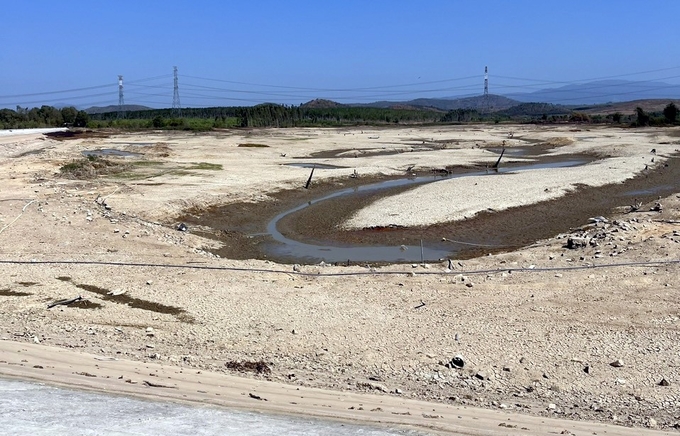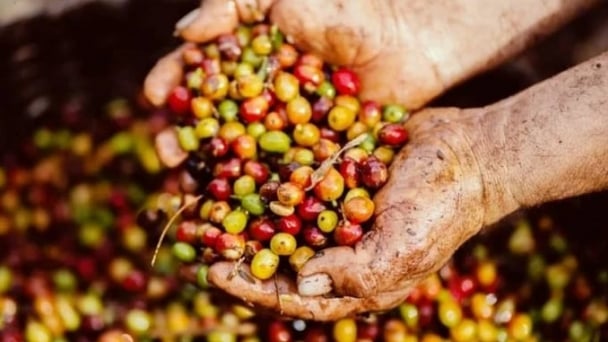June 17, 2025 | 16:37 GMT +7
June 17, 2025 | 16:37 GMT +7
Hotline: 0913.378.918
June 17, 2025 | 16:37 GMT +7
Hotline: 0913.378.918

Ta Mon reservoir in Ham Thuan Nam district with a bare bottom. Photo: KS.
Since the start of 2024, the province of Binh Thuan has experienced prolonged drought, low humidity, and rapid evaporation as a result of El Nino's effects, which have caused reservoirs to experience a significant water deficit. Certain small-scale reservoirs with limited water accumulation capacities, including Tan Lap, Ta Mon, Tan Ha, Song Dinh, Song Khan, and Tra Tan, have experienced drought conditions.
Certain water supply projects, including Duc Binh (Tanh Linh), Ham Duc, Ham Phu (Ham Thuan Bac), Long Hai, Ngu Phung (Phu Quy), and Duc Phu (Ham Thuan Bac), have been under construction since 2004. However, due to their limited capacities and reliance on groundwater and water from small streams, these projects are unable to provide sufficient raw water for plant operations during the dry season.
As of the present, the Department of Agriculture and Rural Development of Phan Thiet city and 41 communes, divisions, and towns in Bac Binh, Ham Thuan Bac, Ham Tan, Tanh Linh, and Duc Linh districts comprise the province of Binh Thuan. Approximately 26,872 households in these municipalities are experiencing water shortages.
In addition, 961 hectares of winter-spring crops in the districts of Duc Linh, Ham Thuan Nam, and Tanh Linh would lack irrigation water in 2023-2024, which have a negative impact on productivity. People in Tan Lap commune (district of Ham Thuan Nam) must now wait for rainfall to alleviate the drought at Ta Mon Lake, which has been dried out for approximately one month.

Currently, many dragon fruit areas in Binh Thuan lack irrigation water. Photo: KS.
A resident of the village of Ta Mon, Mr. Khong Minh Tien, stated that the current drought and shortage of irrigation water in the region are severe. Due to the lack of rainfall since October, hundreds of hectares of dragon fruit have become susceptible to potential harm. Locals utilize water from drilled wells to pump into pre-excavated ponds to store water for irrigation to sustain the dragon fruit gardens. Nonetheless, drilled well water sources are also progressively diminishing. People are required to cease taking water from the wells for a brief period of time.
According to Mr. Nguyen Huu Phuoc, the Deputy Director of Agriculture and Rural Development in Binh Thuan, the arrival of El Nino has resulted in water scarcity and drought in recent years, affecting both local production and way of life. Particularly in 2014, dozens of thousands of households in the province of Tuy Phong, Bac Binh, Ham Thuan Bac, Ham Tan, and La Gi are without access to potable water. Water scarcity impacts the winter-spring 2013-2014 and summer-autumn 2014 agricultural seasons across the province, resulting in the reduction or halt of production on 17,659 hectares of crops.
Severe water scarcity for daily use affected more than 112,000 inhabitants in 2016 in districts including Ham Thuan Bac, Ham Thuan Nam, Bac Binh, Tuy Phong, Ham Tan, and Phan Thiet City. In relation to agricultural water usage, water scarcity compelled the province to reduce or stop from producing on a total of 12,100 hectares of crops; drought caused harm to approximately 3,900 hectares of crops.

At the end of February, Vo Xu Pumping Station, Duc Linh district had a shortage of irrigation water. Photo: KS.
A total of 4,900 households in Binh Thuan encountered water scarcity issues in 2019. Water scarcity negatively impacted 600 hectares of perennial crops and 380 hectares of rice, resulting in diminished agricultural yields.
Binh Thuan, along with the province of Ninh Thuan, is among the driest regions in the country. Indeed, the rainy season has been primarily concentrated in three months (July, August, September) since 2016.
However, there remains a shortage of water storage projects that aim to accommodate agricultural production and daily needs during the drier months, despite the efforts made during the rainy season. Numerous ambitious water reservoir projects have been developed but have yet to receive financial investment or be built.

Currently, the proportion of agricultural production areas in Binh Thuan served by irrigation works is very low. Photo: KS.
According to Mr. Nguyen Huu Phuoc, the province of Binh Thuan has forty distinct varieties of water reservoirs; however, the intended total storage capacity of these reservoirs is no more than 362 million cubic meters. In the province, the annual water demand for agricultural production, daily life, and other economic sectors is projected to be approximately 1.34 billion cubic meters until 2030, leading to a substantial deficit.
At present, a mere 20% of the province's agricultural production area actively employs water from irrigation projects, resulting in inefficient land use. In addition, the majority of irrigation canal systems are earthen canals that have not yet undergone solidification, which results in water loss throughout operation and extraction.
The primary sources of water for agricultural productivity and daily needs in the La Nga River delta region are water that flows through power turbines and is also supplied to downstream areas by the Ham Thuan hydropower plant. To date, however, no investment has been made in water storage reservoirs in the delta region of the La Nga River.
To store water resources in a proactive way in response to drought, Binh Thuan requires additional large water reservoirs. Therefore, the central government provides financial support to Binh Thuan province for the construction of the 51 million cubic meter Ka Pet water reservoir in the Ham Thuan Nam district between 2021 and 2025. The implementation, nevertheless, encounters numerous challenges and impediments, resulting in project advancement setbacks.
In relation to this matter, Mr. Nguyen Huu Phuoc stated that geological surveys indicate that the primary dam's proposed site is situated on relatively feeble geological formations. It is a zone of strongly weathered rock interspersed with moderately weathered rock, which compromises the dam line's safety. Investors, consulting firms, and specialists require sufficient time to examine and contemplate the management of this geological region in order to guarantee its technical and financial sustainability. Furthermore, time is consumed when conducting forest inventory and assessment, developing plans for reforestation, issuing permits for surface water exploitation, and composing environmental impact assessment reports.

Model of La Nga 3 lake headworks. Photo: Kim So.
Therefore, the feasibility study report for the project has not been completed to submit to the competent authorities for appraisal and approval as a legal basis for implementing subsequent tasks. There is still a lot of work to be done, so the investor needs to be more proactive.
It is critical to resolve irrigation water shortages and drought in the southern region by investing in the La Nga 3 reservoir, which has a capacity of more than 400 million cubic meters but has not yet been constructed. The Project Management Board for Investment in Construction of Irrigation Works 7 was tasked by MARD with the development of prefeasibility analyses for seven distinct projects.
However, neither an evaluation nor inclusion in the mid-term public investment plan for 2021-2025 have been conducted on these initiatives. The bottleneck pertains to the La Ngau 3 reservoir, housing the small La Ngau hydroelectric plant. This facility remains in the National Electricity Development Plan and has not been removed; furthermore, the investor for this hydroelectric plant has not reached a consensus, thereby impeding the progression of the project.
Translated by Linh Linh
![Turning wind and rain into action: [5] Hue applies modern technology in disaster forecasting](https://t.ex-cdn.com/nongnghiepmoitruong.vn/608w/files/news/2025/06/17/z6704423696987_15fd32ffc26d590d204d520c9dac6786-nongnghiep-093938.jpg)
(VAN) In Hue city, modern technology has recently been applied in meteorological and hydrological forecasting and warning, helping to reduce the damage caused by natural disasters.

(VAN) A cutting-edge farming technique being implemented on an experimental ranch in Arizona's Sonoran Desert has already saved a billion gallons of water over five years, according to Civil Eats.

(VAN) Poultry and pig production and the environment can be boosted through enhanced water technology, according to new research.

(VAN) Coffee prices on June 16, 2025 are unchanged. In Vietnam, local trading prices are holding steady, ranging around VND 112,000 – VND 112,500/kg.
![Turning wind and rain into action: [4] Bringing climate bulletins to remote and isolated areas](https://t.ex-cdn.com/nongnghiepmoitruong.vn/608w/files/linhnhp/2025/06/14/1152-z6704423696987_15fd32ffc26d590d204d520c9dac6786-nongnghiep-151141.jpg)
(VAN) The Vietnam Agriculture and Nature Newspaper interviewed Mr. Vu Thai Truong, Acting Head of Climate Change and Environment at UNDP Vietnam, to gain deeper insight into how climate bulletins are delivered to farmers.

(VAN) In Tien Giang, a high-tech shrimp farm has developed a distinctive energy-saving farming model that has yielded promising results.
![Turning wind and rain into action: [3] 300.000 farmers benefit from agro-climatic bulletins](https://t.ex-cdn.com/nongnghiepmoitruong.vn/608w/files/news/2025/06/12/e5a48259d6a262fc3bb3-nongnghiep-125122.jpg)
(VAN) The agro-climatic bulletin has become a valuable tool for farmers in the Mekong Delta. After more than five years of implementation, the initiative is gradually being expanded nationwide.